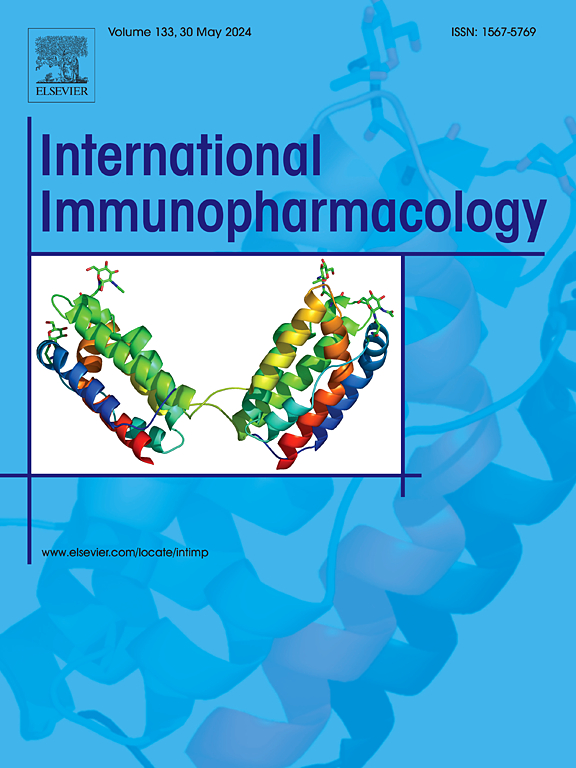Hydroxysafflor yellow A attenuates the inflammatory response in cerebral ischemia–reperfusion injured mice by regulating microglia polarization per SIRT1-mediated HMGB1/NF-κB signaling pathway
IF 4.8
2区 医学
Q2 IMMUNOLOGY
引用次数: 0
Abstract
Background
Hydroxysafflor yellow A (HSYA), an active component isolated from Carthamus tinctorius L., has demonstrated potent protective effects against cerebral ischaemia/reperfusion (I/R) injury. Microglial polarisation plays a crucial role in I/R. However, the mechanism by which HSYA regulates microglial polarisation remains unclear.
Objective
To explore the mechanism of action of HSYA on the phenotypic polarisation of microglia stimulated by lipopolysaccharide (LPS) in a mouse model of I/R injury.
Methods
BV2 cells injured by LPS and a modified middle cerebral artery occlusion/reperfusion (MCAO/R) model were used to mimic I/R in vitro and in vivo, respectively. BV2 cell morphology was assessed by optical microscopy, and cell viability was evaluated using the CCK-8 assay. The effect of HSYA on MCAO/R mice was assessed using the Longa assay, brain index, triphenyl tetrazolium chloride, and haematoxylin and eosin staining. LDH, NO, IL-6, TNF-α, and IL-10 levels were measured using corresponding ELISA kits following the manufacturers’ protocols. M1 and M2 type microglia markers, including CD86, CD16/32, iNOS, YM1/2, TGF-β, and Arg, were detected by western blotting. M1 and M2 cell surface markers (CD86 and CD206) were detected using immunofluorescence. Molecular docking, DARTS, and CETSA were applied to investigate the interactions between HSYA and SIRT1. The role of HSYA in regulating the binding of HMGB1 to SIRT1 was tested using co-immunoprecipitation. Proteins related to the HMGB1/NF-κB pathway were also analysed by western blotting.
Results
HSYA promoted microglial polarisation from M1 to M2 type in LPS-induced BV2 cells and MCAO/R mice. HSYA significantly reduced M1 polarisation markers, including IL-6, TNF-α, CD86, CD16/32, while increasing the expression of IL-10, Arg, YM1/2, TGF-β. Furthermore, compared to the MCAO/R group, HSYA significantly improved neurological scores, brain index, and infarct volume and normalised nucleolar arrangement. Molecular docking assessment showed that HSYA exhibited strong binding SIRT1 and significantly improved the interactions between SIRT1 and HMGB1. HSYA also decreased the expression of cytoplasm-HMGB1 and reduced the P-P65/P65 ratio.
Conclusions
HSYA attenuates LPS-induced and MCAO/R-induced inflammatory responses by modulating microglia polarisation. This effect is associated with the SIRT1-mediated HMGB1/NF-κB signalling pathway.
羟基红花黄A通过sirt1介导的HMGB1/NF-κB信号通路调节小胶质细胞极化,减轻脑缺血再灌注损伤小鼠的炎症反应。
背景:羟基红花黄A (hydroxyysafflor yellow A, HSYA)是一种从红花(Carthamus tinctorius L.)中分离得到的活性成分,对脑缺血/再灌注(I/R)损伤具有较强的保护作用。小胶质细胞极化在I/R中起关键作用。然而,HSYA调节小胶质细胞极化的机制尚不清楚。目的:探讨HSYA对脂多糖(LPS)刺激下小胶质细胞表型极化的作用机制。方法:采用LPS损伤的BV2细胞和改良的大脑中动脉闭塞/再灌注(MCAO/R)模型,分别在体外和体内模拟I/R。光学显微镜观察BV2细胞形态,CCK-8法检测细胞活力。采用龙格实验、脑指数、氯化三苯四氮唑、血红素和伊红染色评估HSYA对MCAO/R小鼠的影响。采用相应的ELISA试剂盒检测LDH、NO、IL-6、TNF-α和IL-10水平。western blotting检测M1、M2型小胶质细胞标志物CD86、CD16/32、iNOS、YM1/2、TGF-β、Arg。免疫荧光法检测M1和M2细胞表面标志物CD86和CD206。应用分子对接、dart和CETSA研究HSYA和SIRT1之间的相互作用。采用共免疫沉淀法检测HSYA在调节HMGB1与SIRT1结合中的作用。western blotting分析HMGB1/NF-κB通路相关蛋白。结果:HSYA促进lps诱导的BV2细胞和MCAO/R小鼠的小胶质细胞由M1型向M2型极化。HSYA显著降低M1极化标志物,包括IL-6、TNF-α、CD86、CD16/32,同时增加IL-10、Arg、YM1/2、TGF-β的表达。此外,与MCAO/R组相比,HSYA显著改善了神经学评分、脑指数、梗死体积和正常核仁排列。分子对接评估显示,HSYA对SIRT1具有较强的结合能力,显著改善了SIRT1与HMGB1的相互作用。HSYA还降低了细胞质hmgb1的表达,降低了P-P65/P65比值。结论:HSYA通过调节小胶质细胞极化来减弱lps诱导和MCAO/ r诱导的炎症反应。这种作用与sirt1介导的HMGB1/NF-κB信号通路有关。
本文章由计算机程序翻译,如有差异,请以英文原文为准。
求助全文
约1分钟内获得全文
求助全文
来源期刊
CiteScore
8.40
自引率
3.60%
发文量
935
审稿时长
53 days
期刊介绍:
International Immunopharmacology is the primary vehicle for the publication of original research papers pertinent to the overlapping areas of immunology, pharmacology, cytokine biology, immunotherapy, immunopathology and immunotoxicology. Review articles that encompass these subjects are also welcome.
The subject material appropriate for submission includes:
• Clinical studies employing immunotherapy of any type including the use of: bacterial and chemical agents; thymic hormones, interferon, lymphokines, etc., in transplantation and diseases such as cancer, immunodeficiency, chronic infection and allergic, inflammatory or autoimmune disorders.
• Studies on the mechanisms of action of these agents for specific parameters of immune competence as well as the overall clinical state.
• Pre-clinical animal studies and in vitro studies on mechanisms of action with immunopotentiators, immunomodulators, immunoadjuvants and other pharmacological agents active on cells participating in immune or allergic responses.
• Pharmacological compounds, microbial products and toxicological agents that affect the lymphoid system, and their mechanisms of action.
• Agents that activate genes or modify transcription and translation within the immune response.
• Substances activated, generated, or released through immunologic or related pathways that are pharmacologically active.
• Production, function and regulation of cytokines and their receptors.
• Classical pharmacological studies on the effects of chemokines and bioactive factors released during immunological reactions.

 求助内容:
求助内容: 应助结果提醒方式:
应助结果提醒方式:


